Information
from Naturalist Guide
 JP, our new Ranger guide, arrives. We head
out toward Mt. Baldy with Katy's class.
JP, our new Ranger guide, arrives. We head
out toward Mt. Baldy with Katy's class.
The kids want to know why JP has a walkie talkie. He says it is for bad
weather and an emergency situation. As we walk, R plays soccer with C's
apple. Katy tells the girls to "get with the class."
We pause and gather at the Mt. Baldy sign. The Ranger says,
"I'm Jean Pierre." "My buddies call me J.P. I like questions."
He asks the kids, "Why do you think it is called Mt.
Baldy?"
They say, "Because nothing grows on it." and "It sticks up
in the air."
He says it is also called "smoking dome." "Why is this? There
is nothing to catch fire."
The kids say that the wind blows the sand.
"Yes, it is the wind off the lake that blows the sand and it looks
like fog or smoke."
He tells the kids that Mt. Baldy moves 4-5 feet a year.
It is moving into the forest that lies between us and the sand dune. "What
will happen next?" he asks.
"The forest will be buried in sand," the kids predict.
JP tells them that there is a very special kind of tree, the cottonwood,
that cannot be buried. He tells us to listen for why and how later in the
hike.
JP tells us that there are three rules to follow on the hike.
"I'm going to be the leader."
"Stay on the trail," and
"Let's have fun, but of course you have to listen."
We head out.
He spies a columbine in bloom and goes to it, pointing it out as "one
of my favorite flowers."
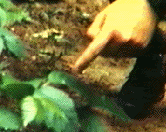 Farther down the path he points out poison
ivy. "Leaves of three, let it be," he says.
Farther down the path he points out poison
ivy. "Leaves of three, let it be," he says.
But he explains that many other plants have leaves of three,
so he holds up his fingers to explain how the vein structure is shaped and
the shape of leaves with a middle leaf "like a football" and the
outer leaves like "hands with thumbs."
In addition, the leaves can be red, the berries are white and the leaves
are shiny.
"If you contact poison ivy," he explains, "wash the contacted
area with soap and water. Use cold water, because hot water opens
your pores. Cold water closes the pores."
Poison ivy is not useless. "Animals eat the leaves and birds eat the
berries."
I am struck by the diagram of this activity. We move from station to station
and hear the appropriate information. We are "receivers" that
can fine tune the information by asking questions. I wonder whether students
will be able to set the agenda (or reset it,) whether this structure can
be open to responding to the moment, or whether the weight of the time limit
and set number of stations closes the process to serendipity.
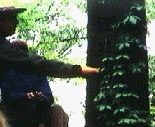 We pause on the trail for JP to point out a
Virginia Creeper vine on a tree. We move down the trail.
We pause on the trail for JP to point out a
Virginia Creeper vine on a tree. We move down the trail.
 We pause again for JP to point out a tree trunk
standing near the trail. It is a giant black oak. JP explains the tree is
decomposing.
We pause again for JP to point out a tree trunk
standing near the trail. It is a giant black oak. JP explains the tree is
decomposing.
He grabs a fist full of soil from the center of the tree
and passes it around to some boys standing near him. The kids smell the
soil in their hands. We move on before many kids get to touch the "soil."
We pause and JP explains "this is a habitat. It is a black
oak forest. What other kinds of habitat are there?" The kids call
out others -- savanna, marsh, dunes, wetlands. JP adds desert and the lake,
"Lake Michigan is a habitat. Habitat must contain food, shelter, water,
air and space," he explains. "Food, water, shelter, space. Habitat
is a wonderful space," he chants. Like the Pied Piper, he leads the
kids on down the trail chanting this couplet.
We pause by a tree that hangs over the trail. You can see beneath it that
the soil of this area rests on a sand dune.
We pause again. JP points out witch hazel. He explains that it disperses
its seeds by shooting them out when the tree is disturbed. Then he talks
about other means of dispersal. There are clinger seeds that attach to animals.
There are seeds that are eaten by animals and then dispersed in scat. These
"are distributed in little fertilizer packets." he explains.
 We come out of the forest and into the bright sun.
We come out of the forest and into the bright sun.
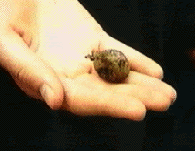
A boy finds a snail and brings it to me to photograph,
but does not interrupt the Ranger.
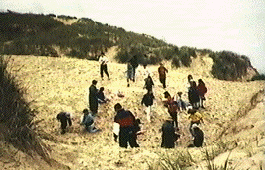
JP leads us to a recent "blow
out" in the dunes, where the children gather around him, sitting
on the sand. From my perspective on the rim, it looks like he and the children
are sitting in the giant scoop of a hand
JP explains that there is a leeward and windward side of a dune. "Which
is leeward?" he asks. (these questions give kids a chance to draw upon
their previous knowledge.) C says it is the "side of the dune that
is sheltered."
"Exactly," JP responds. He then illustrates both concepts with
his hands.
Charlotte is standing next to me. She comments, "If you don't teach
the children young enough, they won't get this. And then its too late."
JP explains that marram grass stops sand from moving across the area, it
makes the dune stable.
"This is a blow out," he explains. It used to be filled with sand,
but the wind has blown the sand away. "What happened to the plants
that grew at the top of the dune?"
"They are gone," the children say.
JP explains that once a "trail cut across the living dune." and
"People walking on the grass killed the grass. There was no vegetation
to hold the soil, so (wind) erosion created the blowout, making this big
hole in the dune."
 R. raises her hand.She has noticed that there are fragments
of wooden walkway mostly buried in the dune.
R. raises her hand.She has noticed that there are fragments
of wooden walkway mostly buried in the dune.
"Why did they build the walkways there?" she
asks.
JP explains that sometimes managers will sacrifice one area by making a
trail. It is better to have a guided disturbance than it is to have everyone
crossing an area off the trail.
"But didn't that (walkway) cause a disturbance?" R asks.
"Obviously things got worse because now there is only sand covering
the wooded walkway."
"You're right," says JP. "It didn't work. They messed up.
Sometimes the planners do mess up. It was silly to place a trail through
a living dune. You should only make a trail on a stable dune. That's the
best question I every had."
He then talks about "succession."
C. says it means "the order of what happens with dunes, how the sand
gradually becomes covered by plants."
JP explains, "This blow out is the best place for succession to happen.
It is like a baby growing older. Changes happen. A fresh blow out is a baby.
In time it changes. Look over here, plants are already moving in here."
He points to new tufts of grass at the edge of the dune.
"If left alone, succession would happen here. Plants would stabilize
the dune, make soil, more plants would move in, it would become forest,
eventually.
Katy asks the kids, "What is the missing ingredient in succession?"
"Time," they respond.
JP says that he wants to talk about diversity next.
"Bio-diversity," the kids call you.
"Yes," he says, "You guys are incredible."
He tells them that there are 370 National park lands. The Indiana Dunes
is ranked number 4 in bio-diversity. There are 1400 different plants and
animals living within its boundaries. He names 6 different kinds of snake.
L asks, "Do you allow parties here?"
"Sure. People picnic here all the time," JP says.
"Won't that ruin it even more?" she asks.
For the first time, JP does not quite know what to say.
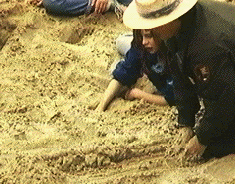
He moves on to how Lake Michigan was formed.
Using the sand, he shows how the glacier pushed up hills and left a giant
hole that formed the lake.
Charlotte uses this moment to say that some kids need to
go down to the lake and get a water sample. They will test the water when
we return to school.
We move along out of the blow out toward the leeward edge of the big dune.
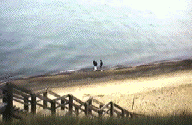
E and C are dismissed to go down for the water sample.
They are told to meet up with us on the far dune. We take
the path, they head down the dune to the lake shore.
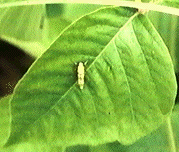
K and L come up to me.
"Look at the beautiful bug over there." they say.They take me
to a bush with a sparkling bug on it, that is very beautiful. I photograph
it. Then we hurry to catch the group.
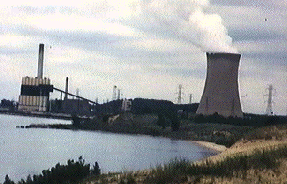 The group pauses to inspect the vista of a power plant
on the water's edge.
The group pauses to inspect the vista of a power plant
on the water's edge.
It is coal powered. JP explains that it pollutes the air,
but then people also want electricity. "How do we strike a balance?"
he asks. "You have to get your power from somewhere. Would you do with
less electricity to reduce the pollution caused by its production?"
he wonders.
We walk on. We notice a black line curving on the dune's surface. It is
the line of the old forest, JP explains.
We reach the top of the leeward side of the dune. The dune drops off at
a steep slope.
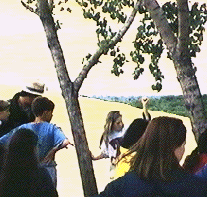
A few cottonwood trees stand on the rim.
JP explains that as the sand covers the tree, it sends
out roots and keeps growing. The cottonwoods here go down 35 feet. That's
how they keep from being covered by the sand, by growing taller as the dune
gets deeper.
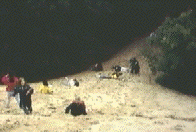 He tells the kids they can go down the dune, but not to
run.
He tells the kids they can go down the dune, but not to
run.
"Either walk or go on your bottom." he directs.
"Can we roll?" someone asks
"Okay."
R says to L, "I'm going on my butt."
As the kids start down the dune,
Katy tells them to stop and wait at the bottom.
E rolls down the dune, going very fast.
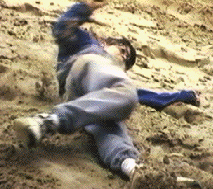
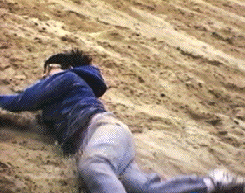
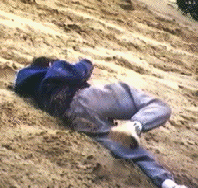
The other kids watch. At the bottom he stands up and cries
out, "Roll down, its the awesomest." The other boys start to roll.
Then some of the girls roll.
When everyone is down, Rick takes a photo from the top, and then walks back
using the inside trail with T. who did not want to go down the steep slope.
JP gives his final part of the talk.
"This place, like other park areas, belongs to you." he tells
them. "So take care of it. Come back often, but remember, you cannot
collect anything." He says that when he was a kid he collected stones
and mushrooms. "I didn't know" he explains. "But now I know,
so I don't do it."
He takes out a cottonwood branch he took from some girls in the group who
had picked it from a tree. He says, "They should not have picked it,
but they didn't know." Then he shows us how the seeds disperse, and
passes the branch around. C comes to me and asks me to feel the center of
the seed cluster." It feels silky," she says.
We leave the dune.
When we arrive in the bus area.
The kids brush off sand and dump sand from
their shoes. 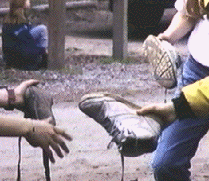
"Let's make a dune, guys" one of the girls says.
C says that it was hard to climb back up the dune from the lake (after getting
the lake water sample.) We could hear E panting from where we were,"
R says.
Rick and Katy talk about the last part of the trip. The roll down the hill
was "a good way to end it." Rick says the kids "learned stuff,"
but also had "fun." The afternoon reinforced the information presented
in the morning.
On the way home, Charlotte shows me her sketch book.She has worked out perspective
of different drawings and settled on pastels and water color as medium for
the work next week.
Return to Field Trip Menu
 JP, our new Ranger guide, arrives. We head
out toward Mt. Baldy with Katy's class.
JP, our new Ranger guide, arrives. We head
out toward Mt. Baldy with Katy's class. Farther down the path he points out poison
ivy. "Leaves of three, let it be," he says.
Farther down the path he points out poison
ivy. "Leaves of three, let it be," he says.  We pause on the trail for JP to point out a
Virginia Creeper vine on a tree. We move down the trail.
We pause on the trail for JP to point out a
Virginia Creeper vine on a tree. We move down the trail. We pause again for JP to point out a tree trunk
standing near the trail. It is a giant black oak. JP explains the tree is
decomposing.
We pause again for JP to point out a tree trunk
standing near the trail. It is a giant black oak. JP explains the tree is
decomposing.  We come out of the forest and into the bright sun.
We come out of the forest and into the bright sun. 

 R. raises her hand.She has noticed that there are fragments
of wooden walkway mostly buried in the dune.
R. raises her hand.She has noticed that there are fragments
of wooden walkway mostly buried in the dune. 


 The group pauses to inspect the vista of a power plant
on the water's edge.
The group pauses to inspect the vista of a power plant
on the water's edge.
 He tells the kids they can go down the dune, but not to
run.
He tells the kids they can go down the dune, but not to
run. 


